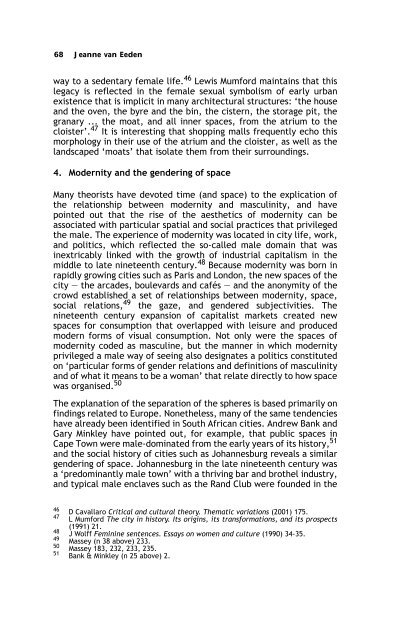Sex, Gender, Becoming - PULP
Sex, Gender, Becoming - PULP
Sex, Gender, Becoming - PULP
Create successful ePaper yourself
Turn your PDF publications into a flip-book with our unique Google optimized e-Paper software.
68 Jeanne van Eeden<br />
way to a sedentary female life. 46 Lewis Mumford maintains that this<br />
legacy is reflected in the female sexual symbolism of early urban<br />
existence that is implicit in many architectural structures: ‘the house<br />
and the oven, the byre and the bin, the cistern, the storage pit, the<br />
granary ... the moat, and all inner spaces, from the atrium to the<br />
cloister’. 47 It is interesting that shopping malls frequently echo this<br />
morphology in their use of the atrium and the cloister, as well as the<br />
landscaped ‘moats’ that isolate them from their surroundings.<br />
4. Modernity and the gendering of space<br />
Many theorists have devoted time (and space) to the explication of<br />
the relationship between modernity and masculinity, and have<br />
pointed out that the rise of the aesthetics of modernity can be<br />
associated with particular spatial and social practices that privileged<br />
the male. The experience of modernity was located in city life, work,<br />
and politics, which reflected the so-called male domain that was<br />
inextricably linked with the growth of industrial capitalism in the<br />
middle to late nineteenth century. 48 Because modernity was born in<br />
rapidly growing cities such as Paris and London, the new spaces of the<br />
city — the arcades, boulevards and cafés — and the anonymity of the<br />
crowd established a set of relationships between modernity, space,<br />
social relations, 49 the gaze, and gendered subjectivities. The<br />
nineteenth century expansion of capitalist markets created new<br />
spaces for consumption that overlapped with leisure and produced<br />
modern forms of visual consumption. Not only were the spaces of<br />
modernity coded as masculine, but the manner in which modernity<br />
privileged a male way of seeing also designates a politics constituted<br />
on ‘particular forms of gender relations and definitions of masculinity<br />
and of what it means to be a woman’ that relate directly to how space<br />
was organised. 50<br />
The explanation of the separation of the spheres is based primarily on<br />
findings related to Europe. Nonetheless, many of the same tendencies<br />
have already been identified in South African cities. Andrew Bank and<br />
Gary Minkley have pointed out, for example, that public spaces in<br />
Cape Town were male-dominated from the early years of its history, 51<br />
and the social history of cities such as Johannesburg reveals a similar<br />
gendering of space. Johannesburg in the late nineteenth century was<br />
a ‘predominantly male town’ with a thriving bar and brothel industry,<br />
and typical male enclaves such as the Rand Club were founded in the<br />
46 D Cavallaro Critical and cultural theory. Thematic variations (2001) 175.<br />
47 L Mumford The city in history. Its origins, its transformations, and its prospects<br />
(1991) 21.<br />
48 J Wolff Feminine sentences. Essays on women and culture (1990) 34-35.<br />
49 Massey (n 38 above) 233.<br />
50<br />
Massey 183, 232, 233, 235.<br />
51 Bank & Minkley (n 25 above) 2.
















